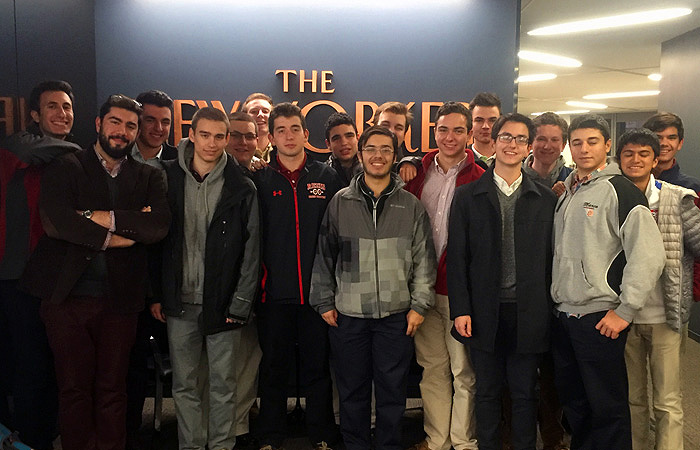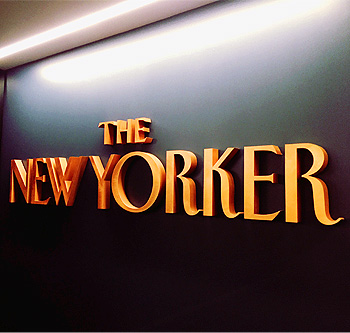
The following reflection was written by John Rindone '16 and Charlie Barton '16, participants in the Senior elective course "Reading The New Yorker at Regis".
 This fall, a group of Regis Seniors had the opportunity to spend a trimester reading and discussing a variety of essays and short stories pulled from the weekly issues of The New Yorker. Mr. David Grunner, who designed and taught "Reading The New Yorker at Regis," decided to offer the elective course to introduce us to and set us on our way to a life-long reading and appreciation of one of the finest weekly publications of culture and ideas. As a capstone to the curriculum, the class was lucky enough to spend time talking with staff writer Rebecca Mead (who graciously came to visit us at Regis) and actually visit and tour The New Yorker’s brand new office on the Freedom Tower’s 28th Floor—a location worth visiting in of itself.
This fall, a group of Regis Seniors had the opportunity to spend a trimester reading and discussing a variety of essays and short stories pulled from the weekly issues of The New Yorker. Mr. David Grunner, who designed and taught "Reading The New Yorker at Regis," decided to offer the elective course to introduce us to and set us on our way to a life-long reading and appreciation of one of the finest weekly publications of culture and ideas. As a capstone to the curriculum, the class was lucky enough to spend time talking with staff writer Rebecca Mead (who graciously came to visit us at Regis) and actually visit and tour The New Yorker’s brand new office on the Freedom Tower’s 28th Floor—a location worth visiting in of itself.
Rebecca Mead has been a staff writer for The New Yorker since 1997 and her work has led her to profile such illustrious figures as classicist Mary Beard and Basketball player Shaquille O’Neal. Just a few days prior to her visit the seniors had read her piece, "The Couture Club," a description of an extravagant Dolce & Gabbana fashion show. Charmed by its vivid depictions of opulence and curious about the author’s intentions behind the piece, the seniors came prepared with insight gleaned from their reading and class discussions. The visit, however, proved to be far more than a discussion of the piece.
Explaining the writing process, she detailed the months of the article’s development as well as the excitement of attending the luxurious fashion show. The class learned much not only about what goes into journalism—eating, sleeping, and breathing one's topic—but also about the pieces they spent the trimester reading and discussing. It is one thing to read an article but another to meet the author, the individual behind the curtain crafting the experience, and indeed the barrier between reader and writer was further torn down by Mead’s pleasant, down to earth demeanor. In addition to hearing the thought process behind the article, the experience of recognizing the person behind it will remain with the seniors for a long time to come. Mr. Grunner's senior class left the room with their perspectives on both reading and writing broadened, and it was a moment they will never forget.
After school on Monday, November 23, we took the 4 train downtown and made our way to The New Yorker offices, arriving just before the late afternoon rush. Warmed by the rays of sundown, the office and its views felt impossibly picturesque. It was truly hard to imagine, when the world’s center seemingly spanned in every direction—up towards Midtown, down the gleaming Hudson—how anyone situated there could conceivably get their work done. Yet, what we also noticed--the cohesive spirit of dedication shared by the entire staff—very much evinced the contrary: that The New Yorker is a work of love as compelling to its readers as to those involved in its production.
The opportunity to tour the office as we did was so unique precisely because The New Yorker usually maintains a no-tour policy. Only thanks to the efforts Mr. Grunner was our class able to gain access, and once there enjoy the guidance and company of Pam McCarthy—the magazine's wonderful Deputy Editor. Still, despite that organizational success, our expectations were admittedly modest: not even Mr. Grunner knew what was in store for us.
The tour itself was remarkably illuminating. McCarthy first explained to us how The New Yorker plan its issues weeks ahead of time. She showed us an office alcove devoted solely to article arrangement; along its wall were various charts and article previews, grouped in accordance with degree of completion and expected publishing date. Further stops at the archives—which held everything ever published by The New Yorker, from E.B White's weekly "Comments" to John Hershey’s Hiroshima—and digital layout department only deepened our appreciation for how passionately the magazine goes about every element of its operations. Additional conversations with those involved in the Art Department, including "Caption Contest" arbiter Colin Stokes, added cool inside perspectives about those unique parts of The New Yorker that everybody loves.
Perhaps most memorable about the entire experience, however, was the dialogue we enjoyed sharing with Editor-in-Chief and occasional contributor David Remnick, who was also joined by Issue Editor Kelly Stout and McCarthy herself. Upon hearing that the class had read a recent piece of his, "After Charleston," Remnick opened the floor to questions; yet upon receiving one, he consistently responded by turning the question back on the asker. And through this Socratic-like approach, he not only challenged us students to actually have a substantive conversation about what we read, but also underscored one element of The New Yorker he had referenced in an earlier comment: that his publication is not a publication of obligation—a classifier he attributed to newspapers like The New York Times. By contrast, he maintained, The New Yorker is a publication of ideas—one fundamentally driven by passionate writers and interested readers willing to engage what they have to say. In other words, that The New Yorker’s responsibility as a publication is not necessarily to report on conversations or developments that everyone knows about, but rather to shed light on or reflect phenomena that intrinsically deserve such attention. Reflecting on this ethos of the magazine, Remnick noted that his greatest challenge as Editor is to retain The New Yorker’s soul as it moves away from being an exclusively print publication to a multiplatform, more modernized production.
The whole New Yorker staff seemed fascinated by our visiting them, or just that Regis offered such a class to begin with. Yet we were the ones—newer and longtime readers of the magazine alike—who were thoroughly enthralled by such an unexpected inside peek.